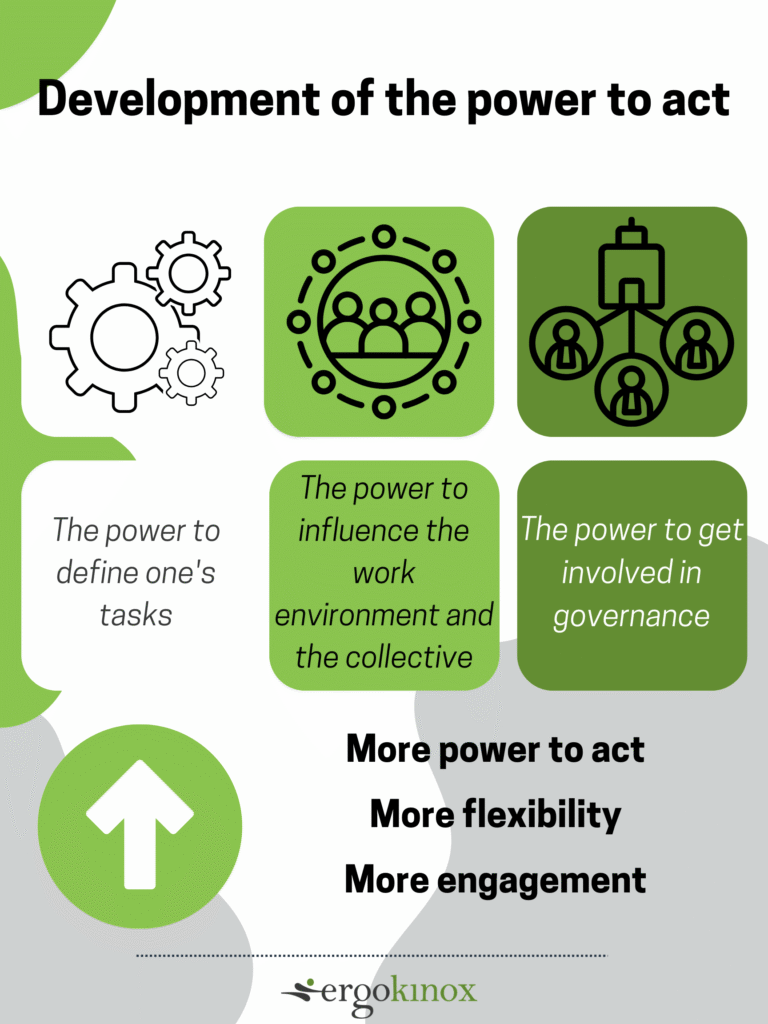ARTICLE
Combating disengagement through participatory ergonomics
Foreword
Why are exoskeletons proliferating in Quebec and Canadian workplaces?
The Gallup Institute defines the concept of disengagement as follows:
“Employees who are not really active, perform their work in a neutral way, in search of meaning in their work.” They are likely to evolve in a positive or negative direction depending on the circumstances.
The reasons for disengagement are numerous and some solutions seem to elude organizations struggling with a growing rate of presenteeism. Countering this phenomenon is a major challenge, but it seems possible by acting, among other things, on the “power to act” of workers.
The power to act of workers
The power to act is defined as the ability of individuals to influence their work environment and to actively participate in the transformation of their working conditions. According to Yves Clot, a famous occupational psychologist, it is about the possibility for workers to develop their activity, their objects, and their tools in a professional context in order to achieve a job well done.
Clot emphasizes the notion of a job well done, “which consists, for the employee, of achieving the goals he or she has set for him or herself, or that have been set for him or her, and thus achieving a result that is defensible in his or her own eyes. ” In short, the power to act is the ability to intervene in the organizational constraints of work.
These constraints are addressed in the ergonomic intervention proposed by the Ergokinox team. Participatory ergonomics is an approach in which workers are actively involved in the analysis and design of their own work environment. This method can greatly increase workers’ power to act.
How can workers’ power to act be developed?
Essentially, the development of empowerment is achieved by encouraging professional autonomy and the leeway of workers.
To do this, three (3) areas of intervention are designated:
- The power to define one’s tasks
- The power to influence the work environment and the collective
- The power to get involved in governance

The power to define one’s tasks
Working to a set pace or with a prescribed, or even imposed, sequence of execution are examples of organizational elements that can restrict the leeway of certain workers. Consequently, allowing them to define certain parameters of the work task helps to increase this leeway, giving rise to productivity ensured by workers who are more involved and responsible for their work. For example, involving nursing staff in reviewing protocols or planning care schedules can greatly improve their job satisfaction and optimize the quality of patient care.
The Ergokinox collaborative approach
In our interventions, participatory ergonomics gives workers the opportunity to participate in decisions that affect their daily work. This can improve their sense of control and autonomy, thus increasing their motivation and job satisfaction. We advise and support companies in developing a proactive and collaborative approach to evolving prescribed work in line with internal expertise. Allowing employees to evolve prescribed work is a manifestation of recognizing the internal expertise of one’s organization.
The power to influence the work environment and the collective
Allowing the main users of the work environment to adjust their work environments seems logical, doesn’t it? Well, that is exactly what is proposed in this line of action, where workers are collectively encouraged to identify and propose possible solutions for adjusting the physical environment with which they interact. For example, workers should be involved in reorganizing their workstation, allowing them to choose the order of assembly steps and/or the arrangement of tools and components, which can reduce fatigue and increase efficiency.
The Ergokinox collaborative approach
The most experienced employees regularly modify elements of the environment, work tools and even production processes. During our interventions, we pay the utmost attention to these changes made by employees, as they are the trigger for initiatives and projects that can benefit the rest of the organization. By enabling the creation of pilot projects and implementing solutions from initiatives of expert employees, it is possible, in the long term, to increase the leeway of a majority of workers and multiply the opportunities for continuous improvement of the environment, tools and processes.
The power to get involved in governance
Finally, a powerful lever for developing the power to act is to build spaces for dialogue or vertical communication channels that allow workers to make themselves heard. It is well known that a work environment where employees feel listened to and valued tends to generate more commitment and job satisfaction.
The Ergokinox collaborative approach
During our regular interventions, the ergonomist proposes the creation of formal and informal spaces for dialogue within the company.
For example, the company can set up:
- Regular meetings between members of the OHS committee (including members of the management team) and the work teams;
- Joint working groups on specific ergonomic issues;
- Discussion forums open to all employees;
- Physical or digital suggestion boxes;
- Etc.
These channels aim to facilitate the transmission of realities from the field to the decision-making bodies. The objective is to enable workers to express their ideas, concerns and suggestions for improvement in a constructive framework.
In short
The more rigid the constraints suffered by workers, the greater the risk of disengagement. Increasing the power of workers to act is an excellent strategy for creating a climate of trust and collaboration in the organization. Increasing the power of workers to act is allowing the organization to fully tap into the potential of each work expert, who may have the innovative solution to meet your next big challenge.
Participatory ergonomics reinforces this idea by actively involving workers in the analysis and design of their own workstations. By adopting this approach, we not only remedy the potential disengagement observed, but also promote a dynamic of continuous innovation where each worker, considered an expert in their work, contributes directly to improving the efficiency and safety of their environment.
